Mexico and the World
Vol. 4, No 3 (Summer 1999)
http://www.profmex.org/mexicoandtheworld/volume4/3summer99/sowing_seeds.html
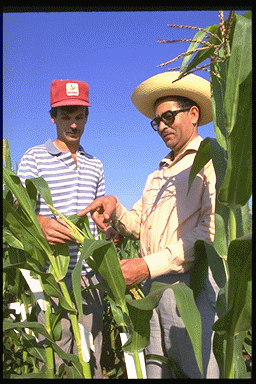 CIMMYT scientist
CIMMYT scientist
and farmer examining crops
Courtesy of CGIAR
|
Sowing
The Seeds of the Green Revolution
The Pivotal
Role Mexico and
International
Non-Profit Organizations
Play in
Making Biotechnology
an Important
Foreign Policy Issue for the 21st Century
|
Introduction
Biotechnology and the Green
Revolution will be increasingly significant foreign policy issues in the
next century. At issue is how will we feed ourselves? How will scientists,
politicians, and agro-businesses make use of important new genetic discoveries
that are currently bio-engineering new plant species and hybrids? Agriculture
accounts for 80-90% of water usage, how will nations resolve their food
and water shortages in the future when they share the same water source?
Both President Jimmy Carter and Nobel Peace Prize winner, Norman Borlaug
are working to raise public awareness of the strategic relationship between
food production, natural resources, and world peace through their efforts
to support new public information efforts such as Future Harvest and the
Carter Center's Global 2000 program. It is President Carter's firm belief
that the "first step toward peace is eradicating hunger? There can be no
peace until people have enough to eat. Hungry people are not peaceful people."1
The current international
debate over these issues does not fall along traditional foreign North-South,
East-West, or regional alliances. Instead, the parties are divided into:
1) those who believe that today's malnourished populations should acquire
new farming technology in order to feed themselves and their families;
2) those who want to deter new technologies that destroy biodiversity and
the environment; and 3) those who want to create new foods. The first group
argues that world population has tripled since 1930 and will continue to
grow reaching an estimated 8.3 billion by 2025 and possibly 10 billion
by the end of the 21st century.2 There simply will not be enough resources in some countries to feed their
populations with today's technology.3 Therefore,
new farming techniques must be developed and spread throughout the world,
especially to underdeveloped regions. The second group includes a growing
number of underdeveloped countries who want to ensure sustainable development,
a term that incorporates preservation of biodiversity and traditional customs.
This concept was defined in Agenda 21, a document drafted at the 1992 U.N.
Earth Summit in Rio de Janeiro to provide an environmental action plan
for the next century. Lastly, the third group encompasses the biotechnology
industry, which is moving rapidly forward with new DNA experiments that
are shaking the foundations of traditional agricultural science. Based
on their new discoveries, food production is undergoing radical changes
and it appears that this trend will only continue to accelerate.
As this article will demonstrate,
historical precedent provides guidelines for resolving this international
debate. The Green Revolution has been changing food production for over
close to 50 years. It began in Mexico in the 1940's with funding from the
Rockefeller Foundation. By the 1970's, the Rockefeller Foundation joined
with other international non-profit organizations to create a number of
international agricultural centers under the umbrella organization, CGIAR.
Over the decades, these international centers developed a network of scientists,
agriculturists, and policymakers with a track record of developing consensus
with developing nations and environmentalists. While they were developing
this conscensus, they were also developing new plant hybrids using more
non-DNA traditional methods that yield greater nutritional value. During
the 1990's, CGIAR has been undergoing a profound restructuring. It is challenged
with finding new donors for its programs, redirecting its efforts in the
Post-Cold War period, and assessing the new challenges created by biotechnology.
Its history provides an interesting review of the timeline of the Green
Revolution and offers some important perspectives, which may shape future
events and the terms of the biotechnology debate.
What
is the Green Revolution?
In the 1960's, "lifeboat"
population experts predicted that the exploding world population in the
underdeveloped would lead to drastic Malthusian events such as mass starvation
in Asia. However, the catastrophes depicted in such best seller books as
William and Paul Paddock's Famine 1975! America's Decision: Who Will
Survive? and Paul Ehrlich's The Population Bomb were successfully
diverted by innovative agricultural research experiments in the late 1960's
and early 1970's that became known as the Green Revolution.4The
first phase of the Green Revolution resulted from research begun in Mexico.
With support from the Rockefeller Foundation, in the 1960's Nobel Peace
Prize winner Norman Borlaug spread the Green Revolution to Asia and around
the world.
In the 1980's, the Green
Revolution entered a second phase of development as agriculturists attempted
to address the criticisms leveled against the first phase of the Green
Revolution. Critics had stressed that the first phase only emphasized high-yield
Western crops such as wheat and used chemical fertilizers that destroyed
tropical ecosystems.5 Green Revolution agriculturists
began diversifying in the 1970's as they dedicated new resources to rice
experiments and tropical plants. They also worked diligently on seed preservation,
biodiversity, and sustainable agriculture issues. By the 1990's, the explosion
of gene-modified foods and the biotechnology industry shook the traditional
perceptions of all professional agriculturists. Historian James Wilkie
notes that these changes created new opportunities to produce and process
food staples with greater amounts of nutritious vitamins, minerals, and
proteins. As described in greater detail in this article, Grupo Maseca
has been at the forefront of adding nutritional supplements to enrich tortillas
and Norman Borlaug has been leading the way in the development of efforts
to increase the quality content of protein in maize, known as QPM.6
Today, the way humans grow
food is being radically changed by new discoveries underwritten by a growing
multi-billion dollar biotechnology industry. Astounding new discoveries
are occurring on a regular basis. For example, in June 1999, Israel announced
the discovery of "super plants" with technology that can accelerate tree
and plant growth by 50%. This same month, NASA launched plant research
experiments aboard the Discovery shuttle testing the feasibility of producing
plants engineered to produce human proteins and vaccines that can be eaten.
The enormous changes created by these new discoveries are rapidly restructuring
the food industry. The Biotechnology Industry Organization estimates that
in the United States in 1998, 25% of the corn, 38% of soybeans, and 45%
of cotton was gene-modified and 33% of all dairy cows used a biotech hormone
to increase milk production. Furthermore, the U.S. Grocery Manufacturers
of America estimate that within a decade, "95% of all U.S. crops will probably
be biotech."7
As a leading agricultural
exporter, the United States is actively promoting the exportation of biotech
or gene-modified foods around the world. It is firmly supported by other
countries such as Argentina, Chile, and Uruguay that have developed their
own strong biotech industries. According to Chilean delegates at the recent
February 1999 Cartagena meeting of UNCED, "bioengineering is safe, proven
and an environmentally sound technology with a myriad of benefits."8 As debate at this United Nations meeting demonstrated, the lack of agreement
over bio-engineered foods is profound. Over 600 passages of the Biosafety
Protocol, a document drafted at the1992 U.N. Earth Summit in Rio de
Janeiro to regulate trade in genetically modified organisms such as pest-resistant
food and pharmaceuticals have not been ratified.9 Europeans do not necessarily agree with U.S. support for the biotechology
industry. European consumers are concerned that gene-modified foods will
lead to health problems. These fears have prompted the international environmental
movement to brand gene-modified foods as "Frankenstein foods" and their
proponents "genetic imperialists."10
Mexico
-- The Site of the First Green Revolution Experiments
Mexico has been at the center
of Green Revolution agricultural experiments for over 50 years. It is a
tested leader in this field and therefore, well prepared to find progressive
and innovative solutions to food production and sustainable development.
Contemporary analysts may reason that this is because Mexico is a member
of NAFTA and therefore poised to bridge the gap between the developed and
underdeveloped worlds. However, history points to a much more complex relationship
between the Mexican Ministry of Agriculture, the U.S. government, and such
international non-profit organizations as the Rockefeller Foundation, CGIAR
(the Consultative Group on International Agricultural Research), and CIMMYT
(International Maize and Wheat Improvement Center).
U.S. Vice President Henry
Wallace was involved in initial discussions that would make Mexico the
site for the first Green Revolution experiments. As a renowned agriculturist,
Wallace had served as President Roosevelt's Secretary of Agriculture from
1933-40. He followed in the footsteps of his father who had served as Secretary
of Agriculture from 1921-24 under Presidents Warren Harding and Calvin
Coolidge. The Wallace family had a distinguished reputation for public
service and agricultural expertise. They founded the hybrid seed company
Pioneer Hi-Breed and for three generations published the popular Wallace
Farmer's Almanac.11 One of Henry Wallace's
personal projects was the creation of the Office of Foreign Agricultural
Relations to categorize the many different types of plant hybrids around
the world.12
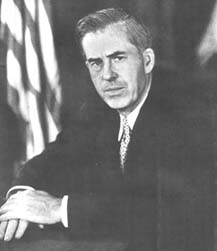
U.S. Vice President Henry A.
Wallace
En Guardia, Vol. I, No. 9, 1942
|
During World War II,
Nelson Rockefeller and Henry Wallace joined forces to pursue their mutual
interest in agricultural research. Both men shared an unshakable belief
that genetic research on climate and disease resistant hybrids could lead
to a solution for world hunger. As head of the Office of Inter-American
Affairs (OIAA), a special wartime agency for Latin America, Rockefeller
was eager to implement President Roosevelt's "Good Neighbor Policy." In
March 1941, OIAA coordinated Wallace's tour of Latin America. 13 After reviewing Mexico's food production resources Wallace came to the
conclusion that, "if anyone could increase the yield per acre of corn and
beans in Mexico, it would contribute more effectively to the welfare of
the country and the happiness of its people than any other that could be
devised." 14 |
Later that year, with Wallace's support, Rockefeller organized the
creation of the Institute for Tropical Agriculture (ITA) to coordinate
scientific research within the Western Hemisphere.15 ITA's primary project was to create a new Inter-American Institute of Agricultural
Science.16 Unfortunately, the project was
never fully successful as President Truman terminated ITA at the end of
World War II.17
The Rockefeller family's
personal and philanthropic interests in agricultural research increased
after World War II. The family supported Henry Wallace's vision in a variety
of ways. First, the Rockefeller Foundation established a Mexico field office
to conduct agricultural experiments. Second, Nelson Rockefeller and a select
group of former OIAA colleagues organized a non-profit organization, AIA
to implement agricultural education programs and hybrid seed experiments.
These Rockefeller projects became prime examples of President Truman's
new "Point IV" policies.18 With the escalation
of the Cold War, Truman announced that the U.S. would fight the expansion
of Communism to Africa, Asia, and Latin America. "Point IV" called for
the exportation of U.S. technical expertise and capital to the developing
world stressing that the American private sector, not the U.S. government
should play the leading role in transferring U.S. technology abroad.19
Although the Rockefellers'
support for the Green Revolution was philanthropically motivated, it can
not be fully separated from its Cold War context. Philip Coomb's 1964 book, The
Fourth Dimension Of Foreign Policy: Educational and Cultural Affairs provides a well documented review of how U.S. philanthropic activities
abroad aided in the fight against Communism.20
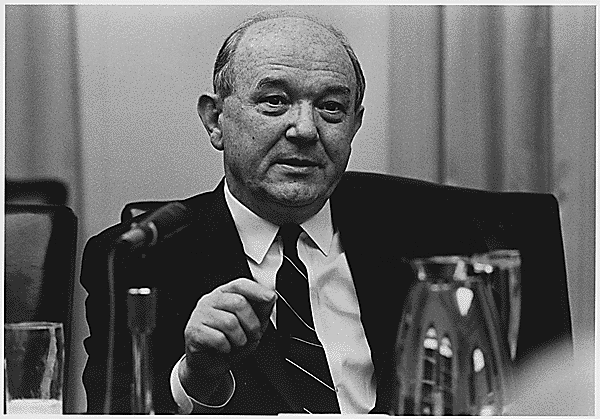
Dean Rusk
Rockefeller Foundation President
(1952-60)and U.S. Secretary of State for U.S Presidents John F. Kennedy
and Lyndon B.Johnson (1961-69) Lyndon Baines Johnson Library
NLJ, Austin, TX NLJ-WHPO-VN066
|
Rockefeller Foundation President Dean
Rusk was a prime actor in this movement. He incorporated Cold War ideology
into the organization's original mission statement noting that the "well-being
of mankind" now "depended on the developing nations who lack the capital,
trained leadership, educated people, and political stability." 21 From 1961-69, Dean Rusk would pursue this philosophy and Cold War agenda
as Secretary of State for Presidents Kennedy and Johnson. Due to his influence,
the Rockefeller Foundation's funding for international program funds tripled
from $6 million in 1955 to $19 million in 1966. 22 A large portion of this money went to providing for fellowships. 23 In addition to these changes, the |
foundation shifted its support to population studies, international relations,
legal and political philosophy, institutional support for the arts, historical
research, and agriculture.
The important role that the
new agriculture program played within the Rockefeller Foundation's administrative
structure is evident by the fact that two of its twelve Presidents have
been agriculturists. As described in greater detail below, J. George Harrar
was responsible for opening the Rockefeller Foundation's Mexico field office.
After his tenure in Mexico from 1943-52, he returned to headquarters to
serve as Deputy Director for Agriculture from 1952-55, Director for Agriculture
from 1955-59, Vice President from 1959-61 and President of the foundation
from 1961-72. Under his guidance, the foundation joined in cooperation
with other U.S. foundations and inter-governmental organizations to form
CGIAR. In April 1998, Gordon Conway, became the welfth President of the
foundation.24
An ecologist, he was an early critic of pesticide spraying.
Several months before assuming his current position, he published The
Doubly Green Revolution, Food For All In The 21st Century. This book
describes his views on sustainable agriculture. He is a steadfast supporter
of integrated pest management and believes that "genetically engineered,
drought-tolerant and salt-resistant crops can 'green' huge areas of barren
land where many of the world's poorest people eke out a living." 25 Since assuming the presidency, he has provided important leadership on
international agricultural matters by calling for a global forum to discuss
biotechnology as an important foreign policy issue for the 21st century. 26 |

Gordon Conway
Ecologist, university administrator
and current President of the Rockefeller Foundation (1998-Present). As
a British citizen, he is the first non-American to serve in this capacity.
"The Rockefeller Foundation www.rockfound.org.
|
Rockefeller
Mexico Field Office
In 1943, the Rockefeller
Foundation signed a formal agreement with the Mexican Department of Agriculture
to open a Mexico Field Office. This agreement was part of the Mexican government's
policy between 1945-65 to increase basic food production. At the time the
agreement was signed, Mexico was importing wheat and corn. Wheat yields
were particularly low and the use of fertilizer virtually unknown. The
Rockefeller Foundation's goal was "to help Mexico to help itself" in solving
its food problem.27The office was organized
under the authority of the Mexican Department of Agriculture's newly created Oficina de Estudio Especiales. Its director, J. George Harrar served
as Chief of Special Studies within the Mexican Department of Agriculture.28 Research laboratories and greenhouses were opened at the Mexican National
College of Agriculture in the Mexico City
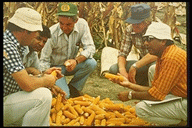
CIMMYT scientists and farmers
examining maize crops.
Courtesy of CGIAR |
suburb of Chapingo. One of the Mexico Field Office's first projects
concentrated on the collection and categorization of seeds from all over
Mexico, North and South America. Experts in plant pathology, genetics,
soil science, and entomology concentrated on crossbreeding seeds to create
new hybrids. Their goal was to discover higher yielding crops. Experiments
tested soil management, fertilizers, insecticides, fungicides, conservation
measures, irrigation, farm machinery and seed varieties. By 1950, an investment
of $1.5 million dollars had produced eight new hybrid corn stocks. Using
these new hybrids, Mexican corn production increased by 8% with 1.5 million
new acres placed into cultivation. 29 |
The successful development of new corn hybrids prompted research on
wheat, bean sorghums and soybeans. The wheat experiments and their chief
agronomist, Norman Borlaug would become famous. Mexican wheat production,
which had been historically limited to the state of Sonora and the Bajío
region of Guanajuato, was plagued by rust and fungus problems. To combat
these conditions, Rockefeller scientists adapted twelve rust-resistant
varieties. In 1950, 1.2 million acres or 60% of the traditional national
wheat acreage was successfully planted with these new rust-resistant strains.30 In
the process of this research, Borlaug achieved an important breakthrough
- the development of a semi-dwarf variety that was insensitive to light.
This trait would allow the Mexican semi-dwarf varietiesto
be exported around the world founding the basis of the Green Revolution.
It allowed Mexico to triple its grain production in a matter of years. 31In
essence, "it was the unusual breadth of adaptation, combined with high
genetic yield potential, short-straw, a strong responsiveness and high
efficiency in the use of heavy doses of fertilizers, and a broad spectrum
ofdisease resistance that has made the Mexican dwarf varieties the powerful
catalyst that they have become in launching the Green Revolution." 32 |
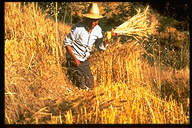
Harvesting wheat.
Courtesy of CGIAR
|
Borlaug developed the Mexican
semi-dwarf varieties by growing different wheat hybrids in two different
locations. One generation was cultivated close to sea level in Sonora at
28 degrees north latitude in the fall where the days were shorter. The
second generation was sown near Toluca, at 18 degrees latitude and 2500
meters above sea level during the summer when days were longer. Special
attention was given to cultivating high-yielding varieties.
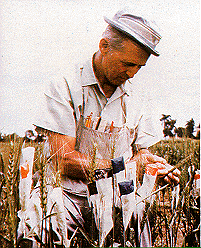
Norman Borlaug
working in wheat field
|
According to Borlaug, without the light insensitive and high-yield
characteristics, "the successful transplantation of the Mexican varieties
into Pakistan and India would havebeen impossible, and the advent of the
Green Revolution would almost certainly have been delayed many years."
His work was noted for his insistence on using what he had available to
make incremental progress. He continued making improvements each season.
In his opinion, "scientific perfectionists who spend a lifetime searching
for the unattainable in biological perfection might consequently, during
a lifetime of frustration, contribute nothing to increasing food production." 33This
was not his method. Today at age 83, he continues to make
improvements in laboratories and fields around the world. |
In the 1950's and 1960's,
the Mexico field office was used as a model for expansion. During this
period, it trained a generation of Mexican agriculturists that would have
significant influence throughout Latin America and the world. Starting
in the mid 1940's, the Mexico field office trained 79 Mexican agriculturists.
Of this initial group, 38 were given fellowships for postgraduate study
in the United States at the universities of California, Kansas, Missouri,
Minnesota, and Cornell. This education program was expanded so that by
1963, a total number of 550 Mexican interns had participated in agricultural
research and training programs. This generation of Mexican scientists assisted
with the development of plant hybrids at Colombia's National University's
School of Agronomy in Medellín and an experimental station near
Bogotá. In 1950, they helped create the Cooperative Colombian Agricultural
Program devoted to maize, wheat, potatoes, forage grasses, and livestock
research.34 In 1955, they assisted Chile with
the establishment of a similar program studying wheat and forage grasses
known as the Cooperative Chilean Agricultural Program. In 1956, research
spread to Asia when the Cooperative Indian Agricultural Program began working
on maize, sorghum, and millet production.35 Within Mexico, this generation created and staffed the new Mexican
National Institute of Agricultural Research established in 1961.
AIA's
Non-Profit Projects in Brazil and Venezuela
As the Rockefeller Foundation
was making inroads in Mexico, Nelson Rockefeller set up his own non-profit
organization to pursue similar work in Brazil and Venezuela. He wanted
to continue projects he had started at OIAA during World War II. He joined
with several former OIAA colleagues to create AIA (American International
Association for Economic and Social Development). Their objective was to
transfer technology and education. They hoped to rapidly modernize basic
infrastructure and services so Latin America could attain a higher quality
of living. They believed that if their efforts failed, the region faced
the prospect that an exploding population would decrease the standard of
living. As a major stockholder in Venezuela's Creole Petroleum, Rockefeller
convinced Shell, Mobil, Gulf, and various other private donors to join
him in
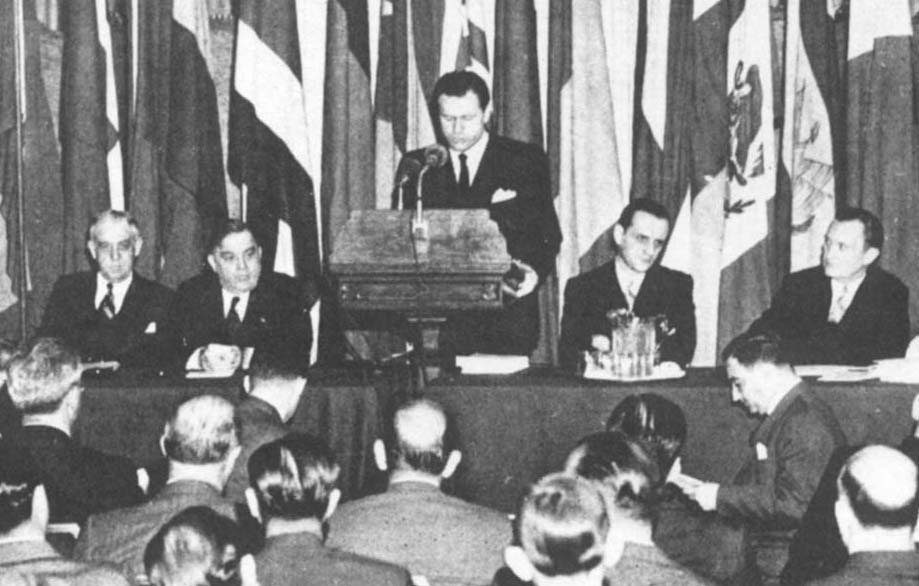
Nelson Rockefeller, 1944
Presenting his plans for economic
development
at a meeting of the Inter-American
Development
Commission in New York City.
EnGuardia, 1944
|
underwriting AIA's projects between 1946-68. 36 When Rockefeller closed AIA in 1968, it was because his projects
were overlapping with USAID programs that were well funded by the Alliance
For Progress. Rockefeller came to the conclusion that U.S. government foreign
assistance projects were better equipped than private efforts to try to
meet the infinite challenge of Latin American economic development. 37 His decision was based on the overwhelming financial resources the Kennedy
and Johnson administrations committed to Latin America in order to keep
it from being drawn into the Communist sphere of influence. |
In today's Post-Cold war period, Nelson Rockefeller's efforts serve
as a historical case study of the private sector's involvement in agricultural
development.
AIA's basic goal was similar
to the Mexico field office's mission in that it sought to "help people
help themselves." In Venezuela and Brazil, AIA worked in rural communities
to create supervised farm credit programs, extension services, demonstration
services, vocational training, agricultural research centers, agricultural
clubs, and development studies. These projects centered on "the man, the
girl and the jeep." The man was an agricultural extensionist, the girl
was the home economist and the jeep was the only vehicle that could make
it through the rough country roads. Operations gradually expanded to include
cattle spraying, construction of a trench silos, and medical visits from
a nurse, physician, and mobile truck stocked with medical supplies. AIA
also constructed community centers where it organized 4-H agricultural
service clubs and home economics training on nutrition and basic sanitation
principles.38
Nelson Rockefeller believed
that farm credit programs could solve the problem of inefficient agricultural
production. Under AIA's Brazilian and Venezuelan farm credit programs,
private banks provided capital and AIA underwrote the loans guaranteeing
repayment. These loans were to acquire basic new technical improvements
such as better hoes, mechanized tractors, fertilizers, and hybrid seeds.
AIA field personnel provided technical expertise to local farmers. In Venezuela,
its farm credit system was known as CBR (Consejo de Bienestar Rural).
It operated between 1948-54 until restrictive Perez Jiménez banking
laws forced it to shut down.39In Brazil, the
farm credit program developed on a state by state basis. The first state
program in Minas Gerais was known as ACAR (Associação
de Crédito e Assistência Rural). It was so popular that
it quickly spread to other states. Eventually the Brazilian government
assumed AIA's financial responsibilities and placed all the state programs
under the federal program EBATER (Empresa Brasileira de Assistência
Técnica Extensão Rural).40
Nelson and David Rockefeller
were fascinated with the possibility of developing new plant species in
Brazil. In the late 1950's, Brazilian President Juscelino Kubitschek commenced
construction on Brasília, a new futuristic capital on the interior
plateau of the state of Goiás. Anticipating that the new capital
would need to farm on the surrounding uncultivated scrub-brush lands known
as the campos cerrados, AIA established agricultural experimental
research stations
nearby. The challenge was toadapt traditional agricultural products
to grow in the distinct aluminum toxic plateau soils. 41 Executive Vice President John Camp believed that AIA could "demonstrate
that these lands, with proper treatment by fertilizer and certain trace
mineral elements can be made productive. The orderly opening up and development
of this area offers new settlement prospects for several million families
and corollary employment opportunities for millions more in related commerce
and industry." 42 |

Construction of Brasília,
1958
Arquivo Público do Distrito
Federal, Brasília, Brazil
|
AIA's subsidiary the IBEC
Research Institute (IRI) oversaw agricultural research projects on the campos
cerrados in Goías and the depleted coffee region of São
Paulo state.43 IRI experimented with weed
control, labor use, irrigation, harvesting, chemicals, and mechanization.44 The Goías experimental station's experiments with phosphorous
and lime fertilizers demonstrated that corn and other crops could be grown
in the campos cerrados.45 IRI employees
were convinced that their work would result in groundbreaking research
that would change the future.46
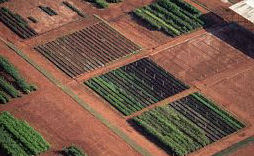
Fields outside of Brasília,
1970
Corbis Pictures, www.corbis.com
|
IRI President Jerome Harrington went so far as to declare that his
organization was "doing more work on the fertility problems than anyone
else in Brazil." 47 As we now know, scientific
research on the cerrados continued with few breakthroughs for the
next 35 years. It was not until 1999 that Norman Borlaug could say, "the cerrado region of Brazil, a very large area long assumed to be infertile because
of toxic soluble aluminum in the soil, may become a breadbasket,
because aluminum-resistant crop strains are being developed." 48 |
Significant progress was made by researchers at the University of
California at San Diego this year when they published their discovery of
a gene that allows plants to detoxify heavy metals that are hazardous to
human health and the environment.49 These
new findings have once again renewed interested in the viability of agriculture
in the cerrados region.
CIMMYT
- International Center for the Improvement of Maize and Wheat
In 1959, the Rockefeller
Foundation's Mexico Field Office internationalized its wheat, maize and
potato projects. By 1963, the Mexican Secretariat of Foreign Relations
had granted these projects full international status resulting in the creation
of the International Center for the Improvement of Maize and Wheat (CIMMYT).
This new organization was located in El Batan on the outskirts of Mexico
City. It received its original funding from the Rockefeller and Ford foundations,
the Mexican government, USAID, United Nations Development Program (UNDP)
and the Inter-American Development Bank (IDB).50As
described in greater detail below, CIMMYT became one of the first four
international centers to form CGIAR in 1971. In the nearly three decades
since its creation, CIMMYT has developed a proven record of close collaboration
with Mexican research institutions such as the Secretariat of Agriculture,
Livestock, and Rural Development (SAGDR). It is currently organized into
5 major research groups - maize, wheat, economics, natural resources and
biotechnology. Its official mission is the development of sustainable maize
and wheat systems for the poor, a problem that it believes it can solve
by improving germplasm with built-in tolerance and resistance to pests,
diseases and environmental stresses.51
Norman Borlaug's initial
wheat research projects conducted at the Rockefeller Foundation's Mexico
Field Office were continued at CIMMYT. He was convinced that the expansion
of his high-yield semi-dwarf wheat varieties throughout the world would
solve world hunger problems. Between 1963-65 with population experts predicting
mass starvation in India and Pakistan, Borlaug concentrated on convincing
local, state and national agencies in these countries to switch to his
high-yield Mexican wheat seeds.52In the process
of shipping his seeds to Asia from Mexico via Los Angeles harbor, Borlaug
encountered numerous challenges. His seeds were held at the US-Mexico border
and almost destroyed by Los Angeles' Watts Riots and a war between India
and Pakistan.53His 1966 book Quiet Revolution
in Wheat Improvement received critical acclaim. He was awarded the
Nobel Peace Prize in 1970 for his work in Mexico and Asia.

Wheat Crop - Courtesy
of CGIAR
|
Borlaug's promotion of high-yielding
Mexican wheat varieties over native plants such as lentils and rice has
caused controversy from the outset. During the first year's harvest in
Kerala, India, hungry protesters rioted against a |
switch from rice to wheat. Borlaug argued that high-yield strains ofindigenous
plants simply did not exist and his Mexican wheat varieties were the best
way to fight starvation. Wheat cultivation could produce the most food
calories and it could be grown in nearly all environments with little pesticide.In
1969-70 approximately 6 million hectares in Pakistan and 14 million hectares
in India were sown to Mexican varieties or their derivatives.54 By 1974, India and Pakistan were on the way to becoming self-sufficient
in food production. Due in great part to Borlaug's efforts, as the world
added an additional 2 billion to the human population between 1965-90,
food production kept pace and even exceeded demand. During
this period,
the global daily per capita calorie intake increased from 2,063 calories
to 2,495.55
This first stage of the Green
Revolution generated controversy because it involved the transfer of a
whole new technology focused on producing plants with the highest yield
possible. Some critics from developing countries decried
wheat as a Western crop that uses enormous quantities of water and fertilizer.
The only way to meet these demands was by developing irrigation and using
organic or chemical fertilizers. Organic fertilizers require large livestock
herds that eat a considerable portion of the harvest and chemical petroleum
fertilizers destroy the environment.56 Other
critics protested against the pressure placed upon Third World governments
to pass policies that give wheat farmers a relatively high price for their
product, create special credit programs for wheat farmers, and promote
the distribution of fertilizers, insecticides, weed killers and machinery.57As
described in greater detail below, these criticisms have resulted in the
modification of goals at CIMMYT and other international agricultural research
groups.
Aside from Borlaug's work,
CIMMYT's has been responsible for a number of other notable achievements.
It has a long tradition of collecting seeds and preserving biodiversity.
By the 1980's its wheat and maize germplasm accounted for approximately
80% of global production. Borlaug's original varieties were replaced with
even more productive varieties that "require little or no pesticides because
of their durable built-in resistance and increased efficiency in the use
of soil nutrients, water and sunlight."58 Today,
more than 75% of the developing world's wheat area (excluding China) has
been planted to semi-dwarf wheat developed by CIMMYT and it's national
agricultural research partners. Its world renown Wellhausen-Anderson Plant
Genetic Resources Center provides long term storage for close to half a
million seed samples including more than 6,000 endangered
farmer-developed maize varieties. CIMMYT research has also helped to rescue
numerous samples held in seed banks throughout Latin America and at the
National Seed Storage Laboratory in the U.S. Its International Wheat Information
System (IWIS) has set global standards by providing computerized data to
researchers worldwide on 1.5 million genotypes of bread wheat, durum wheat
and triticale. CIMMYT has trained over 8,000 researchers working in 80
different countries.59
CGIAR
and its International Research Centers
In 1968, the Rockefeller
Foundation sponsored an important international symposium on "Strategy
for the Conquest of Hunger." At the time, research was being conducted
by four separate international centers including: 1) CIMMYT in Mexico for
maize and wheat; 2) CIAT (the International Center For Tropical Agriculture)
in Colombia for rice, bean, forage grasses and cassava; 3) IRRI (International
Rice Institute) in the Philippines for rice; and 4) IITA (International
Institute of Tropical Agriculture) in Nigeria to study the special foods
and ecosystems related to Africa. As a result of this 1968 symposium, Richard
Demuth at the World Bank's Development Services Department called a meeting
in May 1971 to discuss the rapid proliferation of scientific discoveries.
A group of 28 governments, organizations, and observers agreed to the establishment
of CGIAR (the Consultative Group on International Agricultural Research).60
CGIAR was an umbrella organization
initially created to coordinate the efforts of the four international centers.
As Table 1 and Figure 1 depict, the number of international centers increased
from four to sixteen between 1971-93. According to Lowell Hardin, a Ford
Foundation officer in the 1970's who raised funds to expand CGIAR's international
centers, donors made bilateral grants to individual centers. In other words,
grants were written to CGIAR but they did not go into a general "pot" of
resources. Instead, each donor maintained a bilateral relationship with
each center it supported. CGIAR provided administrative support and management
reviews.61 Today, the international centers
facilitate the exchange of information between national agricultural research
programs. For example, CIMMYT coordinates the flow of information between
the Mexican and Indian government agricultural agencies regarding wheat
and maize issues. IRRI coordinates between these same government agencies
on rice issues.
Table 1
CGIAR's 16
International Centers
|
Acronym
|
International
Center
|
Location
|
Created
|
| |
|
|
|
| IRRI |
International
Rice Research Institute |
Los Banos, Philippines
|
1960
|
| CIMMYT |
Centro
Internacional de Mejoramiento de Maiz y Trigo |
Mexico City, Mexico
|
1963
|
| IITA |
International
Institute of Tropical Agriculture |
Ibadan, Nigeria
|
1967
|
| CIAT |
Centro
International de Agricultural Tropical |
Cali, Colombia
|
1971
|
| CIP |
Centro
Internacional de la Papa |
Lima, Peru
|
1971
|
| WARDA |
West
Africa Rice Development Association |
Bouaké, Ivory Coast
|
1971
|
| ICRISAT |
International
Crops Research Institute for the Semi-Arid Tropics |
Petancheru, India
|
1972
|
| ILRI |
International
Livestock Research Institute |
Nairobi, Kenya
|
1973
|
| IPGRI |
International
Plant Genetic Resources Institute |
Rome, Italy
|
1974
|
| IFPRI |
International
Food Policy Research Institute |
Washington, D.C.
|
1975
|
| ICARDA |
Internacional
Center for Agricultural Research in Dry Areas |
Aleppo, Syria
|
1975
|
| ICLARM |
Internacional
Center for Living Aquatic Resources Management |
Manila, Philippines
|
1977
|
| ICRAF |
International
Centre for Research in Agroforestry |
Nairobi, Kenya
|
1977
|
| ISNAR |
International
Service for National Agricultural Research |
The Hague, Netherlands
|
1979
|
| IWMI |
International
Water Management Institute |
Colombo, Sri Lanka
|
1984
|
| CIFOR |
Center
for International Forestry Research |
Bogor, Indonesia
|
1993
|
Figure 1
Location
of 16 CGIAR international centers
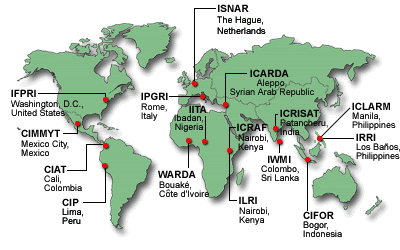
Source: CGIAR
[1999] http://www.cgiar.org/centers.htm
Between 1960 and 1999, CGIAR's
research agenda progressed through several different stages. In the 1960's,
the original four international centers concentrated on rice, wheat, and
maize. In the early 1970's, a second phase of research focused on plants
in the tropics and semi-arid tropics, roots and tubers, livestock and pastures,
cereals, and legumes. By the mid-1970's, work had expanded to genetic resources,
plants in dry areas, and West African rice. In the 1980's, CGIAR concentrated
on institutional strengthening and food policy. During this fourth phase,
its mission was redefined to "increase sustainable food production in the
developing countries in such a way that the nutritional level and general
economic well-being of the poor are improved." This approach emphasized
protecting biodiversity, land, and water.62 In the 1990's, the organization entered a fifth stage focusing on agro-forestry
and forestry, living aquatic resources, and natural resources management.63 Today, CGIAR is a world renowned resource for researchers working on biodiversity
issues. It has one of the largest collections of plant genetic resources
with more than 600,000 samples of over 3,000 crop, forage, and pasture
species. Duplicates of these materials are provided to researchers around
the world. This work is part of a global initiative that aims to promote
"sustainable agricultural growth in developing countries, with special
care devoted to issues such as ethics, safety, and the access of developing
countries to biotechnology products."64
Table 2
Evolving
Forces and Philosophies, 1960s vs. 1990s
| |
1960s
[Phase 1, Green Revolution] |
|
1990s
[Phase 2, Green Revolution] |
| |
|
|
|
| 1. |
Communist Threat |
1. |
Post Cold War
Complacency |
| 2. |
Fear of Famine |
2. |
Secure Food
Supply |
| 3. |
Malthus Rediscovered |
3. |
Environmentalism |
| 4. |
Belief in Science |
4. |
Skepticism
about Science, Biotechnology |
| 5. |
Public
Programs, Institutions |
5. |
Privatization
of Science, NGOs |
| 6. |
Target Growth,
Income |
6. |
Sustainability,
Equity, Poverty |
| 7. |
Technology
Transfer |
7. |
Indigenous
Knowledge |
| 8. |
Paternalistic
Assistance |
8. |
Partnerships,
Outsourcing |
| 9. |
Dedicated Donors |
9. |
Donor Fatigue |
| 10. |
Flexible Funding |
10. |
Impact Driven,
Narrow Project Support |
Source:
Lowell S. Hardin, "Conceptual and Philosophical Bases for CIAT's Founding,"
30 Anniversary
of the Foundation of CIAT 1967-1997 (Cali, Colombia: CIAT, 1998)
CGIAR's donors and members
expanded over the years to include many developing nations and international
NGOs (non-governmental organizations). Their participation and influence
have modified CGIAR's budget and objectives.
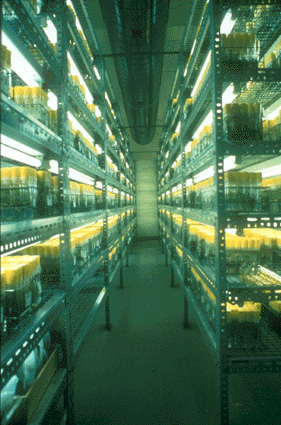
ITC gene bank.
Banana clones stored under slow
growth conditions at reduced temperature (16 C) and low light intensity
(2000 LUX).
Courtesy of IPGRI/INIBAP
|
As Tables 1 and 2 outline, CGIAR's first four international centers
were founded at the height of the Cold War. In the 1960's and 1970's, the
international organizations' priorities mirrored U.S. foreign policy objectives.
Most notable was U.S. concern with the spread of Communism. Due to their
anti-Communist stance, they received abundant financial support from U.S.
foundations, the U.S. government and other developed countries eager to
fight Communist expansion in the Third World. 65 Over the decades, CGIAR's priorities have changed drastically. Today, one
of the key concerns is identifying donors interested in financing the second
phase of the Green Revolution. In 1999, CGIAR's budget accounted for approximately
4% of total worldwide public funding for agricultural research. As Figure
2 depicts, the organization allocated its 1998 budget to five key goals:
increasing productivity, integrating natural resource management, preserving
biodiversity, improving national policies, and building capacity. |
Figure 2
CGIAR 1998
Budget Priorities

CGIAR's
New Programs: GFAR and Future Harvest
On the eve of the 21st century, CGIAR has created two new organizations to reflect modifications
made to its agenda since the 1992 U.N. Earth Summit. One of the most significant
results of this meeting was the drafting of Agenda 21, an action plan defining
important global environmental issues and developing a guide for government
policies in the next century. Agenda 21 ignited heated debate between developed
(North) nations and underdeveloped (South) nations. The South demanded
an emphasis on sustainable development issues such as water pollution,
air pollution, and the degradation of agricultural lands. Underdeveloped
nations expressed their outrage at the excessive "luxury" consumption patterns
of the developed North and defensively noted that their consumption was
"survivalistic" and based a need to eliminate poverty.66 As the number of developing countries participating in CGIAR has increased
in the 1990's, the organization's mission statement has changed to reflect
their views. As a result, CGIAR has recently launched two new campaigns.
GFAR (Global Forum on Agricultural Research) is an initiative aimed at
modifying CGIAR's administrative structure and scientific objectives. Future
Harvest is a media campaign to develop public awareness of the important
links between global peace, the environment, and agriculture.
GFAR's mission is to mobilize
the various players in the global agricultural research community and make
them aware of the serious problems that will be posed by poverty, food
security, natural resources sustainability in the next century.67 Structurally, GFAR is designed to increase collaboration between CGIAR's
international centers, national agricultural research systems (NARS), agricultural
research institutes (ARIs), universities, and private enterprises. Currently
the viability and success of GFAR depends on identifying new financial
donors who are willing to underwrite its goals.68
Future Harvest is a new public
service that disseminates studies analyzing the relationship between agriculture,
livestock, fisheries, forests, and public policy. Its environment, health,
economics, and population experts prepare these studies. Future Harvest
has also created a popular ambassador program, which enlists the support
of such distinguished global leaders. These include: Oscar Arias Sanchez,
President of Costa Rica from 1986-90 and 1987 Nobel Peace Prize winner;
U.S. President Jimmy Carter, former governor and farmer from Georgia; Francine
Cousteau wife of former Jacques Costeau and as President of The Cousteau
Society promoter of global water conservation; Robert S. McNamara, an early
supporter of CGIAR as president of the World Bank, and former president
of the Ford Motor Company, and U.S. Secretary of Defense; Her Majesty Queen
Noor of Jordan an ardent supporter of environmental conservation, peace
and conflict resolution, poverty alleviation, and women's and children's
issues; and Dr. Muhammad Yunus, winner of the 1994 World Food Prize for
his efforts to alleviate hunger in Bangladesh.69
2000
ISSUES
There are several other current
Green Revolution issues that underscore the leading role Mexico and international
non-profit organizations play in making biotechnology an important issue
for the 21st century. As discussed in greater detail
below, they include:
1. The International Debate Over Gene-Modified Foods.
2. Mexico and the Biotech Bt Corn Controversy
3. Mexico's Leadership on Quality Protein Maize (QPM)
4. Mexico's Promotion of Vitamin Enriched Tortillas
5. International Relief - Sowing "Seeds of Hope" in Central America
The
International Debate Over Gene-Modified Foods
The current international
debate over gene-modified foods reflects a power struggle between international
environmental groups and the biotechnology industry. Both groups have radically
different perspectives on the use of resources and their responsibilities
to future generations. The environmentalists protest the use of chemical
fertilizers and new plant hybrids because of their fear that these will
destroy the earth's ecosystem and biodiversity. They are particularly opposed
to the transfer of new agricultural technology to Africa, a continent that
has not begun to change its traditional farming techniques. Green Revolution
agriculturists point out that the environmentalists would prefer to let
people die of starvation rather than employ new technologies. They cite
the case of Sub-Saharan Africa where people are dying of starvation while
environmentalists campaign to ban Green Revolution activities.
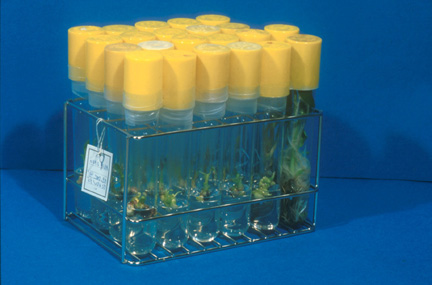
Plants in Vitro
Regeneration of control and frozen
meristem cultures of the cv. Bluggoe,
6 weeks after cryopreservation
Courtesy of IPGRI/INIBAP
|
The biotech industry has adopted a position on the extreme opposition of
the political spectrum from the environmentalists. With the largest sector
of the industry based in the United States, this group has been steadfastly
moving forward under the general premise that bio- engineered farming is
inevitable. Their products have been on the market for less than ten years,
raising questions about long-term health safety. Operating in the global
free-market, there has been little discussion regarding corporate responsibility
for the radical social or health changes their new technology may render.
Simply stated, their objective is to fill a market need as the demand for
food increases with the surge in human population. European consumers
have been the most vocal in expressing hesitation and concern over gene-modified
foods. British polls in 1998 demonstrated that "85% of consumers want genetically
modified foods to be segregated from organically grown products while 77%
want the modified foods to be banned altogether." |
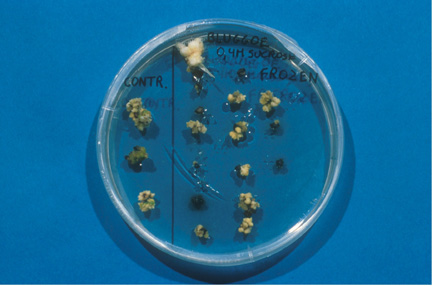
Banana Musa Clones
Prepared for transfer to medium
term storage
Courtesy of IPGRI/INIBAP |
British farmers and food processors have secured government approval
to allow commercial planting of gene-modified crops under strict controls.British
Biscuit, Cake, Chocolate and Confectionery Alliance (BCCA) views "gene-modified
food as inevitable, several products are already in the food chain, and
U.S. producers do not segregate traditional from gene-modified seed."70 In response to this lack of concern for consumer opinion, BEUC (the European
consumers' union) has organized a campaign to segregate gene-modified and
organic food processing.71European consumer
opposition has encouraged U.S. environmentalists to sue the U.S. Environmental
Protection Agency for its failure to ban gene-modified crops.72 Historically, American consumers have felt protected by the watchdog efforts
of both the U.S. Food and Drug Administration and the U.S. Department of
Agriculture (USDA).73 Currently, the USDA
has not required testing for any gene-modified foods, noting that "they
are not aware of any information that shows it is different from regular
food."74
|
On the international level,
the United Nation's Food and Agriculture Organization (FAO) has remained
neutral on the topic on biotechnology. In a January 1999 report issued
on the topic, the FAO urged general caution. However, it also suggested
that biotechnology could "provide solutions for some of the old problems
hindering sustainable development and achievement of food security."75 In light of the general lack of consensus on biotechnology issues, Rockefeller
Foundation President Gordon Conway has been providing leadership on the
issue. In his opinion, European consumer concerns may only serve to stop
progress being made in the field.76 As a solution,
he has recommended the establishment of guidelines, testing and food labeling.
In his opinion, "there must be a new culture, with appropriate systems
and on-going institutional support, that provides careful monitoring, open
reporting and transparency, and a place for public participation about
the impact of plant biotechnology on human health."77Conway
demonstrated his commitment to structuring the terms of the international
debate on the biotechnology issue by meeting with Monsanto Company executives
in June 1999. As the largest biotech plant producer in the world, Conway
asked them to "treat the poor as equal partners in an honest dialogue.
Acknowledge that you are concerned about returns on investment, market
penetration, continued growth and other commercial issues. Admit that you
do not have all the answers but set out those which you do have and commit
to prompt, full and honest sharing of data as you get it."78 In May 1999, Conway called for an international forum on the issue and
the Rockefeller Foundation is dedicating resources to back his efforts.
Mexico
and the Bt Corn Biotech Controversy
As one of the largest cultivators
of bio-engineered Bt corn and home to the monarch butterflies, Mexico has
emerged as the center of one of the latest environmental controversies.
In the May 1999 issue of Nature, Cornell University entomology researchers
reported that genetically modified Bt corn kills monarch butterfly larvae
in laboratory tests.79 Up until the release
of this report, environmentalists had attributed the decline in the monarch
butterfly population to excessive logging and pesticide use. Monarch caterpillars
originate in Canada and the United States where they are possibly being
exposed to Bt corn. After hatching, millions of the monarch butterflies
fly to the western forests of Mexico and Michoacan states for the winter
months. They are not an endangered species, however Mexico, Canada and
the United States are responsible for their protection under the ecological
provisions of NAFTA (North American Free Trade Agreement) implemented in
January 1994.80

Monarch Butterfly
Karen Obenhauser, Monarch Webpage
[1999]
www.monarchwatch.org/gallery/photo/ad2.htm
|
Cornell's findings
are based upon initial laboratory tests. Under specific test conditions,
"44% of monarch butterfly caterpillars that fed on milkweed leave dusted
with Bt corn pollen died. Milkweed is the primary food source for these
caterpillars." Cornell researchers admit that at this stage, their scientific
conclusions are still tentative. According to Cornell entomology professor
John Losey, "the study was conducted in the laboratory and, while it raises
an important issue, it would be inappropriate to draw any conclusions about
the risk to monarch populations in the field based solely on these initial
results." In his opinion, "the proven benefitsof Bt corn outweigh the potential
risks. We can't forget that Bt corn has a huge potential for reducing pesticide
use and increasing yields." 81Splicing genes
from the bacterium Bacillus thuringiensis into the corn genes produces
Bt corn. The Cornell researchers stressed that it poses no threat to humans
or beneficial insects. 82 |
However, French scientists at le Bouchet army research laboratories
reported in the May 29, 1999 issue of New Scientist that Bt dried
spores used on organic crops in Europe may be harmful to the human immune
system.83
Cornell researchers
acknowledge that their next series of experiments with Bt corn and declining
monarch caterpillars must replicate real-life conditions. This summer,
they will be heading to U.S. and Mexico cornfields to conduct additional
research.84 Bt corn has been planted in Mexico
on an experimental basis in certain regions since 1993.85 The U.S. has been planting Bt corn in the Midwest cornbelt since
1996 and its popularity has increased steadily over the past 3 years. In
1996 it accounted for 400,000 corn acres with this figure jumping to 17
million acres or 21-25% of the total planted corn acreage in 1998.86
The Cornell report has strengthened
the activities of environmental groups such as Greenpeace Mexico, which
has been active in organizing protests against genetically modified corn.
According to this organization's spokesman Roberto Lopez, Mexico "is faced
with a new form of domination" - genetic imperialism. He has called on
the Mexican government to "defend the country's genetic diversity and the
more than 300 strains of corn in the country by declaring Mexico a 'center
of origin' of corn in a similar way to France having sole rights to market
wine known as champagne."87
In response to the Cornell
study and Greenpeace protests, the Biotechnology Industry Organization
has publicly acclaimed the important benefits of Bt corn. According to
this organization's spokesman, Dr. L. Val Giddings, "Whatever the threat
to monarch butterflies posed by Bt corn pollen, we know it's less than
the threat of drifting pesticide sprays."88 Giddings
noted that up until the publication of the Cornell's lab tests, the environmentalists
themselves had concluded, "the primary threat to the monarch butterfly
is the loss of crucial winter habitat in southern California and Mexico.
' Threats come from habitat degradation along butterfly migratory routes,
pesticides, and other human activities." Rhetorically, Giddings also added,
"It's not an exaggeration to say more monarchs succumb to high-velocity
collisions with car windshields than ever encounter corn pollen."89
Mexico's
Leadership on Quality Protein Maize (QPM)
Mexicans have long relied on corn as a food staple. As one of the most
prolific and well known of the Green Revolution agricultrists with over
50 years of field experience, Norman Borlaug has remained committed to
developing new corn hybrids that yield corn ears containing high levels
of protein. His non-DNA, traditional plant breeding experiments, known
as the QPM (quality protein maize) project began over 35 years ago in Mexico
at CIMMYT.90 Political support and funding
fo |